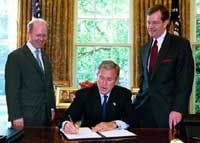President Bush signed an Executive Order creating the Great Lakes Interagency Task Force. The Task Force, under the lead of the U.S. Environmental Protection Agency (EPA), brings together ten Agency and Cabinet officers to provide strategic direction on federal Great Lakes policy, priorities and programs.
The ten agencies together administer more than 140 different federal programs that help fund and implement environmental restoration and management activities in the Great Lakes basin.
At the same time, the President instructed EPA Administrator Mike Leavitt to engage Ohio Governor Bob Taft as Chair of the Council of Great Lakes Governors and Chicago Mayor Richard Daley as Chair of the Great Lakes Cities Initiative to convene a complementary process of regional collaboration. In addition to the ten U.S. agencies, governance of the Great Lakes system is shared with eight U.S. states, more than half a dozen major metropolitan areas, and numerous county, local and Tribal governments. Internationally, governance of the Great Lakes system is shared with Canada.
"Collaboration and coordination – building on the broad collection of existing efforts while ensuring leadership and accountability at the national and international level – is clearly a better way," Administrator Leavitt said. "It is only through the transparent consideration of the rich diversity of perspectives surrounding this international treasure that we can truly accelerate remediation, restoration, protection and conservation."
The Executive Order calls for the development of outcome-based goals such as cleaner water, sustainable fisheries, and system biodiversity and calls on the Task Force to ensure federal efforts target measurable results.
"I plan to meet personally with each of the eight Great Lakes States governors and with many of the region's mayors and stakeholders over the next thirty days," Leavitt added. "The hallmark of our collaboration will be central coordination – of priorities, policies and plans – and local control – of programs, projects and people. I'll also meet with Canadian government officials within 30 days to begin the Task Force's discussion of how our two countries can better work together to address environmental impacts to the Great Lakes ecology."
Administrator Leavitt has already held his first meeting, with Minnesota Governor Tim Pawlenty on May 12, and meetings with the following Great Lakes Governors have been confirmed: May 18, Ohio Governor Bob Taft; May 20, Pennsylvania Governor Edward Rendell; May 24, Michigan Governor Jennifer Granholm and Indiana Governor Joseph Kernan; May 25, Wisconsin Governor Jim Doyle and Illinois Governor Rod Blagojevich, and May 26, New York Governor George Pataki.
The Great Lakes are the largest surface freshwater system on the Earth. They contain more than 90% of the nation's surface fresh water and more than 30 million people in the U.S. and Canada depend on the lakes as a source of drinking water. The daily activities of that population, from the water consumed to the waste returned, directly affect the Great Lakes environment. Major stresses on the lakes also include toxic and nutrient pollution, invasive species and habitat degradation.
Creation of the Task Force continues the commitment made by the Bush Administration with the signing of the Great Lakes Legacy Act of 2002. The Legacy Act addresses the remediation of contaminated sediments in areas of concern. President Bush's 2005 budget proposal includes $45 million for the cleanup of contaminated Great Lakes sediments, a $35 million increase over 2004 levels. In total, between 2002-2004, the Bush administration has invested more than $1.3 billion across the federal agencies to improve water quality, combat invasive species, restore habitat, cleanup brownfields, and establish new, tougher standards for improved air quality by cutting pollution from power plants and diesel engines.
Source: EPA


